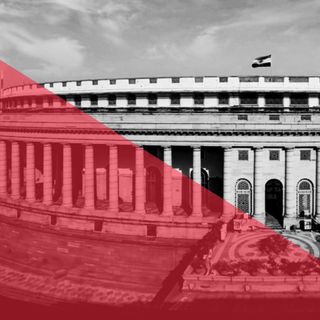
We Are Officially in the Epoch of Disinformation
If you go by mainstream media reports, nobody bombed the hospital in Gaza.
.jpg?rect=0,294,1280,852&w=320&h=213&fit=min&auto=format)
This Tuesday, an Israeli air strike hit the Al-Ahli hospital in Gaza city, killing more than 500 people, as per Gaza’s Health Ministry, Al Jazeera reported. "The hospital was one of 20 in the north of the Gaza Strip facing evacuation orders from the Israeli military," Ahmed Al-Mandhari, WHO Regional Director for the Eastern Mediterranean, told Reuters. Earlier this week, the World Health Organization called Israel’s evacuation orders of the hospitals a “death sentence for the sick and injured.”
"If confirmed, the attack would be by far the deadliest Israeli airstrike in five wars fought since 2008," The Hindu reported. However, most reports about the bombing say that Israel has denied responsibility for the attack. It prompts the question: why does nobody seem to agree on who was responsible? A clip from CNN, for instance, showed an anchor reporting on the incident, stating “IDF said they are looking into the incident, that it could potentially have been a Hamas misfire.” The framing is similar across most large media outlets, who have reported on the attack in passive voice, making the blame unclear.
The careful aversion of blame, and the reporting of the incident as that of Israel and Hamas “trading blame,” speaks to the changing nature of news in a post-truth age: Either nobody or everybody is responsible for a crime of this magnitude. We intuitively understand fake news, amid conversations about its exponential spread over the last decade. But what do we call it when hundreds of children are killed, and there is incomplete and incorrect news about who is responsible?
Misinformation is “false or misleading information," says Jeroen de Ridder. Per definition, misinformation isn’t ill-intended or deliberate. Disinformation, on the other hand, is "The dissemination of deliberately false information, [especially] when supplied by a government or its agent to a foreign power or to the media, with the intention of influencing the policies or opinions of those who receive it” – an OED definition that experts concur with. There’s a case to be made that the most powerful media organizations in the world, by relaying the unverified claims of the Israeli military, are complicit in ushering in an age of disinformation.
There is evidence that the Israeli stance regarding the hospital bombing changed over the span of a few hours. Users on X pointed out that Hananya Naftali, an Israeli influencer drafted in the IDF, stated in a now-deleted post that the Israeli Air Force carried out the bombing and claimed that “a multiple number of terrorists are dead.” Independent fact-checkers on X – like Mohammed Zubair – also showed that Israel’s official X account edited a post that included an unverified video alleging the strikes were from Hamas. Several users also pointed out the double-standards in reporting about Israel and Gaza: while many are reluctant to name Israel in the incident, the previous day, for instance, BBC News ran a piece speculating whether Hamas built underground tunnels under hospitals in Gaza. “The Israeli military, the IDF, has repeatedly accused Hamas of hiding inside these tunnels, effectively using them as human shields,” the article said.
People Are Willing to Excuse Lies, Misinformation That ‘Might’ Come True: Study
As a result of confused media reporting, with scant effort to definitively verify the source of the attack, attention on the hospital bombing has shifted from accountability – which could spur action – to disagreement over who is to blame. The terms of engagement with the crisis in Gaza, therefore, are controlled by influential media organizations who take government claims at face value.
The uncertainty over facts is an extension of media disinformation patterns that have played out throughout the crisis. Earlier, there was the hoax about Hamas "beheading" 40 babies in Israel -- a claim that was first made by i24 News journalist Nicole Zedek, spread on social media, and made its way into various celebrity statements of support for Israel, including even U.S. President Joe Biden's statement. The White House has since walked back the claim that President Biden actually saw images of the crime in question, and the Israeli Defence Force (IDF) itself later stated that it could not confirm evidence of the same. However, Israeli Prime Minister Benjamin Netanyahu's spokesperson repeated the claim, and an IDF spokesperson told The Intercept that they "cannot confirm it officially, but you can assume it happened and believe the report."
Meanwhile, social media discourse has devolved into either condemnation or support for Hamas’ initial attack weeks ago – with the former often ignoring the sociopolitical history of Israel's occupation preceding the current conflict. This ahistorical nature of conversations online, which treat the ongoing crisis at face value, has paved way for rampant disinformation. Government officials, unofficial political workers, and influential celebrities being complicit in the spread of disinformation isn't new. What's different about this particular crisis is that journalists and globally recognized media bodies have also officially joined the fray -- leaving the world reeling from distrust and confusion over whom to believe and what side to take.
Amid Growing Concerns About Misinformation, WhatsApp Launches Fact‑Check Feature
Amid all this, India has acquired an increasingly prominent role in ushering in the age of global disinformation. For example, Indian news channels and journalists, including Barkha Dutt, reiterated the beheading claim sans fact-checking. Earlier last week, several other claims did the rounds online, which online fact-checkers later went on to debunk. One such claim was that Hamas militants sexually assaulted and paraded Israeli women – this too remains unsubstantiated and at least one news outlet has retracted the claim, The Intercept.
A recent Al Jazeera report further found that a significant percentage of anti-Palestinian disinformation came from Indian right-wing accounts on social media – pointing to a coordinated campaign to distort facts on the ground. “With India now exporting its disinformation actors in the Indian mainstream media and on social media in support of Israel, hopefully the world will now realise how the Indian right-wing has made India the disinformation capital of the world,” Pratik Sinha, co-founder of AltNews, said in a post on X.
It’s always been true that fake news reports and images are inevitable in wartime, with all sides engaging in an information war to win ideological support in addition to military support. Experts have called it "epistemic proxy wars" -- where digital mediums act as effective frontiers. This raises the question of the medium: social media platforms used to be relatively better equipped to respond to and quell fake news. Since Elon Musk's takeover of Twitter (now X), however, things have taken a turn for the worse. Musk's disbanding of Twitter's Trust and Safety Council arguably made the platform ripe for spreading fake news, unchecked by any external accountability mechanism. The verification badge, moreover, is one that anybody can pay for and obtain -- leading to greater eyeballs on the accounts who can simply pay, rather than trustworthy ones. "Many large social media platforms have shifted back to prioritizing engagement over reliability for the posts their users see on their feeds," Vox noted, which creates a "friendlier environment for online nonsense and coordinated disinformation." Social media platforms like Instagram, too, have become spaces for the mass dissemination of information from governments themselves, blurring the lines between narrative and fact.
Hate Speeches by Political, Religious Leaders ‘Bulldoze Constitutional Ethos’: Delhi HC
The disinformation also has a specific pattern. Media scholars have pointed out how orientalism often characterizes media reporting on conflict in West Asia, perpetuating anti-Arab stereotypes. Take the fact that the language used to describe all the alleged acts of terror has a pattern: Hamas militants are called "savages," "barbarians," and compared with ISIS militants, who became known for their gruesome execution videos. Such rhetoric is not new: the 1991 Gulf war and the 2003 Iraq War are often considered classic case studies of Western coverage of conflict in Arab countries, where Western military offensives are characterized as neat and "surgical," while their opponents are portrayed as dangerous, unpredictable, and savage. What makes this time different is how the rhetoric not only reframes events from a particular point of view but also lends credibility to incorrect news. Israel’s Prime Minister, for instance, blamed “barbaric” Hamas for the hospital bombing.
What also makes it worse, moreover, is that avenues to respond to disinformation are steadily eroded – through shadowbanning on social media, as many users claimed; or death threats to celebrities like the Hadid family for challenging the mainstream narrative; or denouncements of media organizations’ credibility, as is evident from Israel’s communications minister seeking a shutdown of Al Jazeera. Further, with Israel further having cut off electricity supply to Gaza, and with journalists on ground killed in air strikes, there are even fewer avenues for reporting the reality of the crisis in the region.
The burden of disproving disinformation, then, inevitably falls on the party accused by the more powerful one – turning it into a vicious cycle of unwarranted blame and distrust. Fake reports about Hamas' alleged crimes, recycled images from other conflicts, dehumanizing language, all play a part in framing one side as more "barbaric" than the other, which minimizes the deaths on that side, and accountability.
The European Union issued a letter to Elon Musk last week, urging him to address rising disinformation on X. But the phenomenon speaks to the escalating disinformation crisis globally. In India, the suppression of free speech, fact-checkers, and journalists has led to an exponential rise in fake news -- some of which is even peddled by anchors on broadcast news channels. That a similar pattern of unverified claims being reported as fact until otherwise disproven is now taking place on a global scale shows we've entered an age where misinformation has begun to write itself into history -- superseding the truth.
Rohitha Naraharisetty is a Senior Associate Editor at The Swaddle. She writes about the intersection of gender, caste, social movements, and pop culture. She can be found on Instagram at @rohitha_97 or on Twitter at @romimacaronii.
Related


How WFI Failed Indian Wrestlers – and India
